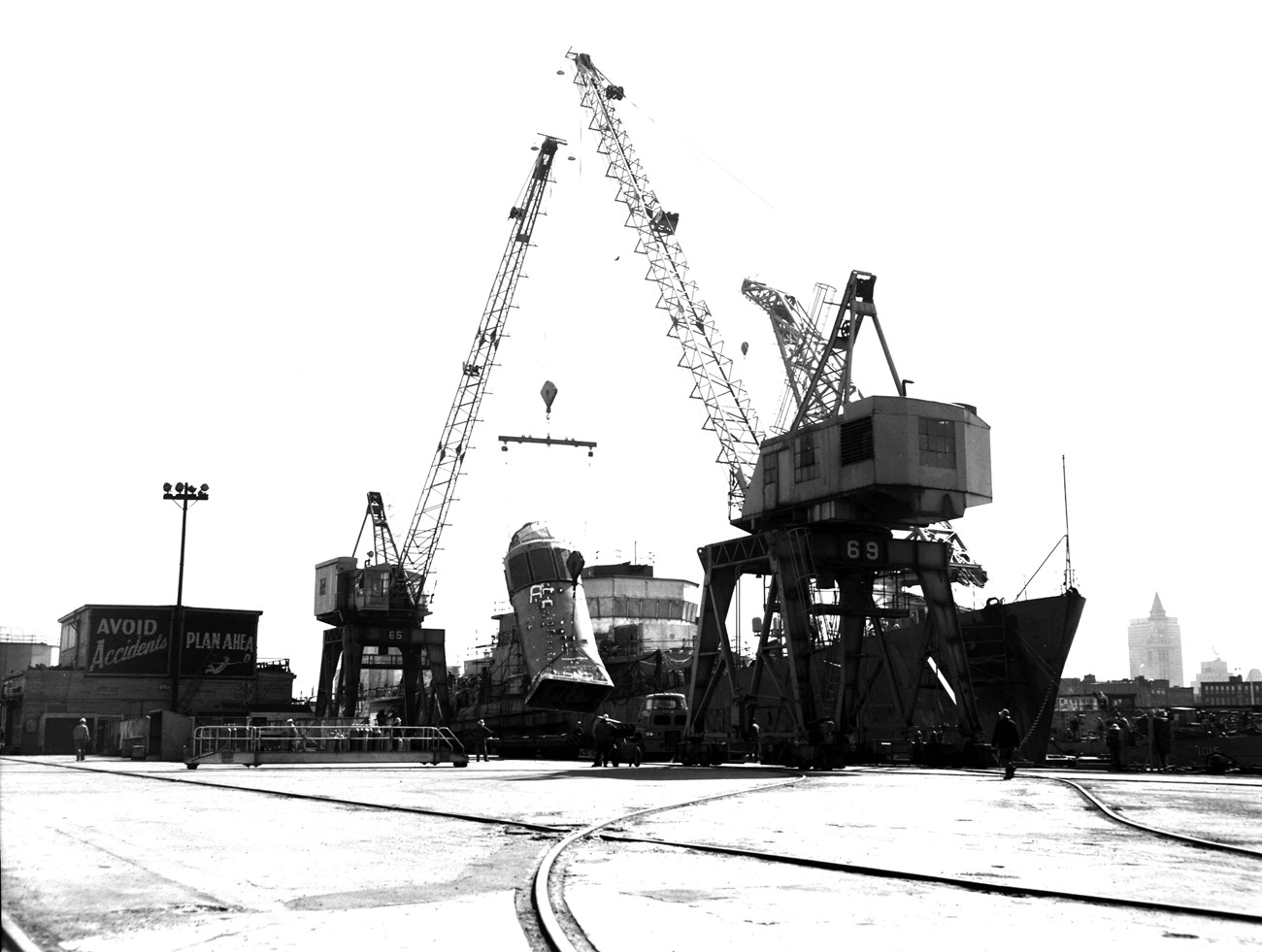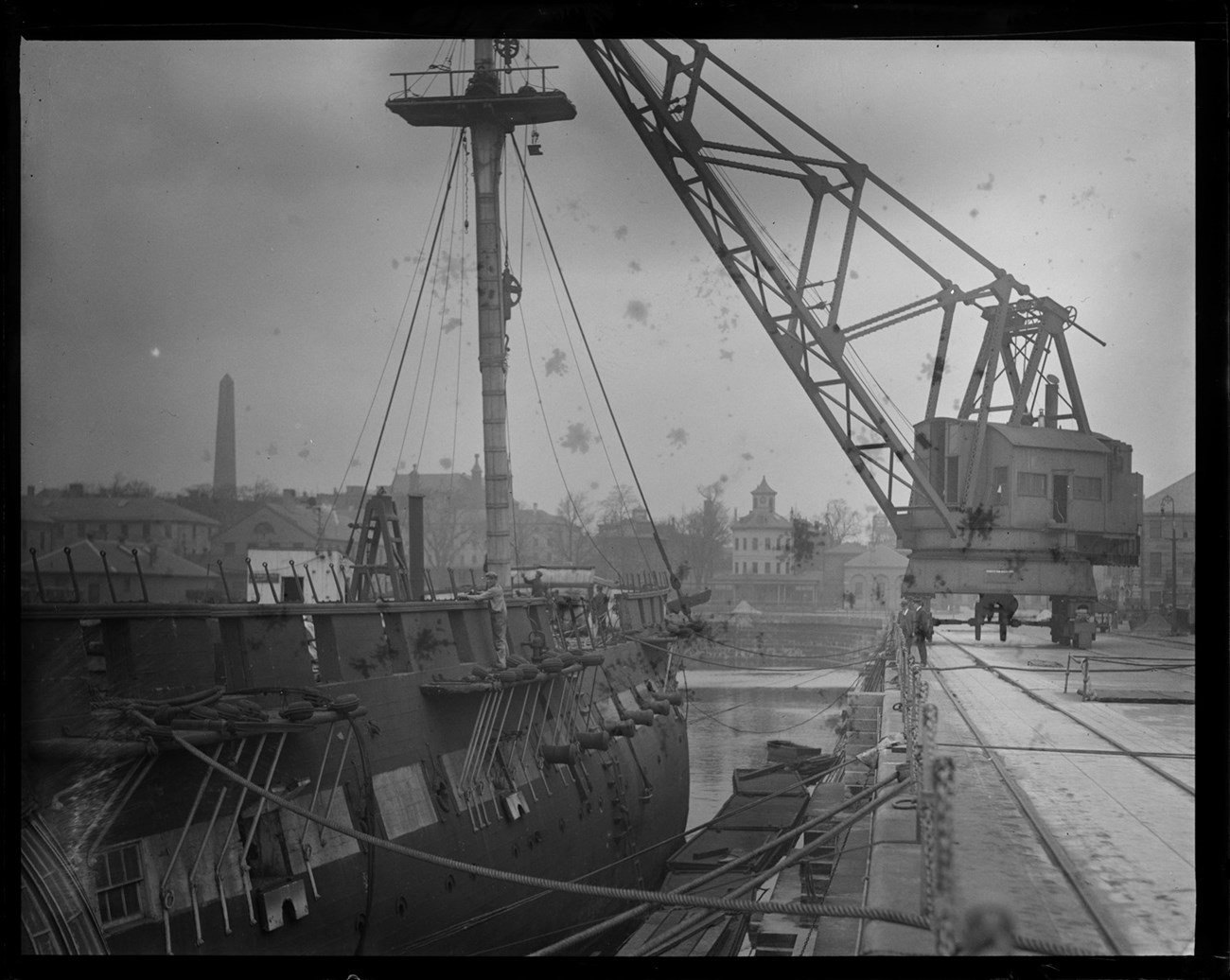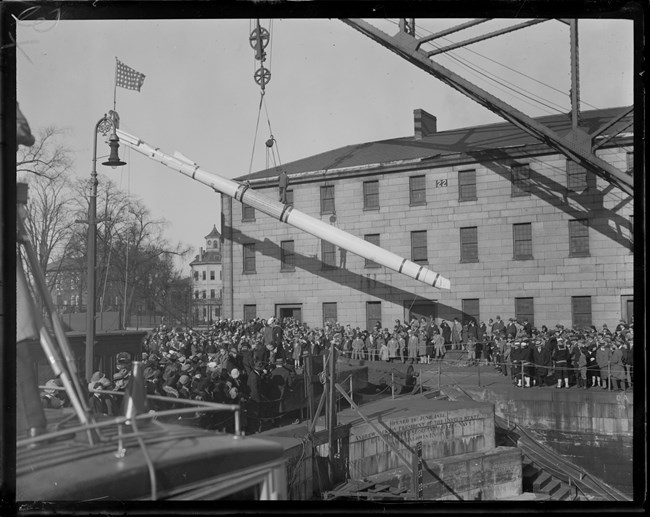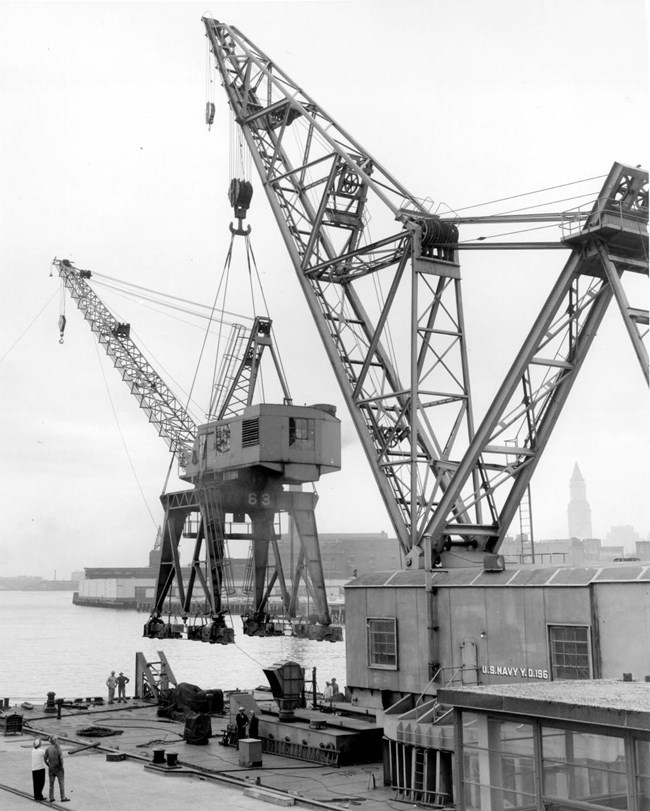Last updated: January 8, 2025
Article
Charlestown Navy Yard: Portal Crane

Boston National Historical Park, BOSTS 10894-1423
A Portal Crane by any other name
From underneath, it is easy to see why the two large cranes still found at the Charlestown Navy Yard—Crane 62 and Crane 65—are called "portal cranes." The open space, or portal, between the metal legs allowed workers and machines to move through the crane rather than having to go around. Conversely, operators could move the cranes along railroad tracks, driving them over blockages and repositioning them where needed.
The "portal crane" design proved very popular in industrial areas where space was at a premium, and the Charlestown Navy Yard was no different. They were so prevalent on docks that they were also sometimes called "dockside cranes." Another nickname, "whirley crane," points to an additional design feature: the top can be revolved—or whirled—around by the operator.
The combination of its open portal, revolving top, and ability to move made the portal crane remarkably flexible and well-suited to its work at the Navy Yard. These cranes played a pivotal role in the building and repairing of ships at the Yard starting from their introduction in the 1940s until the Yard’s closure in 1974.

Courtesy of the Naval Historical Foundation. U.S. Naval History and Heritage Command Photographs, NH 42479
Masting Sheer
As the Charlestown Navy Yard’s last remaining cranes, the portal cranes bear little resemblance to the Yard’s earliest permanent cranes: the masting sheers.
Whereas the portal crane can revolve and move along its 20 foot wide tracks, masting sheers are not much more than two wooden or metal poles attached at the top in the shape of an 'A.' Incredibly strong, sheers are fixed in position; instead of being able to move to a job, a job had to be moved to the sheers.
During the Age of Sail, this was not a problem. Masting sheers were mainly used as their name implies: to install the very large pieces of timber that formed the masts of ships.

Courtesy of the Boston Public Library, Leslie Jones Collection.

Courtesy of the Boston Public Library, Leslie Jones Collection.
New Ships, New Cranes
By the close of the US Civil War, however, ship technology radically transformed since the opening of the Charlestown Navy Yard. Ships like USS Monitor launched in 1861 and those that followed were constructed of plates of iron, powered by steam engines, and armed with larger cannons.
The iron plates, engines, and cannons were heavy, and shipbuilders increasingly relied on the use of cranes to install and maintain these components. Just like the ships, cranes started being made of iron and powered by steam, allowing workers at the Charlestown Navy Yard to keep up with the new demands working on new ships.
The steam powered cranes required constant maintenance and workers charged with their operation arrived an hour earlier than the rest of the crews to stoke the fires and build steam in preparation for the day.
Eventually the Yard operated a whole suite of cranes. Small, mobile railroad cranes, large portal cranes, floating sheers, and hammerhead cranes all operated on the ship-building slipways.

Boston National Historical Park, BOSTS 14782-1.
Prefabrication and Refitting
By the 1940s, technological improvements led to many of the cranes using electric motors. The nature of shipbuilding had advanced as well. Leading up to and during World War II, the requirement for large numbers of ships based on standardized designs meant many private and naval shipyards prefabricated entire sections of ships and rivetted or welded those pieces together to form a complete vessel. This required an increasing reliance on cranes to fit these pieces together. Crane 62 and Crane 65 are good examples of the type of crane used during and after World War II for this style of construction.
After the war, the Charlestown Navy Yard found itself increasingly called upon not for new ship construction but for the refitting of older ships. This included USS Cassin Young, which is moored at the Navy Yard as a museum ship. It is docked near two cranes that performed much of the conversion work of dozens of ships in the 1950s and 60s.
While the heaviest portal cranes used by the Charlestown Navy Yard could safely raise up to 55 tons, some prefabricated structures weighed much more. Cranes could work in pairs for heavier loads. That load rating could be exceeded, but it sometimes led to disastrous results. Two collapses in the 1960s occurred within months of one another, the second of which killed a man in a truck below the crane’s boom.
When the Yard closed in 1974, many of the cranes were scrapped or moved. However, since the Charlestown Navy Yard remained the home of USS Constitution, two portal cranes remained alongside Dry Dock 1 to assist with maintaining the ship. Though all recent work on Constitution is performed using rented roadgoing mobile cranes, the portal cranes still operated as late as the 1990s, and performed the same task as the earliest cranes at the Charlestown Navy Yard: raising the heavy wooden masts back onto Constitution.
Sources
Cushing, Lincoln. “Heavy lifting in the World War II Kaiser shipyards,” Kaiser Permanente. Accessed December 2021, https://about.kaiserpermanente.org/our-story/our-history/heavy-lifting-in-the-world-war-ii-kaiser-shipyards.
Desy, Margherita, M. and Kate Monea. “Constitution's Support System,” USS Constitution Museum, October 21, 2015. Accessed December 2021 https://ussconstitutionmuseum.org/2015/10/21/support-system/.
Goolrick, Faye. Rosie the Riveter/World War II Hom Front National Historical Park Long Range Interpretive Plan. Harpers Ferry Center: National Park Service U.S. Department of the Interior, 2010.
“Moving Whirley Crane CW 3204 to Shipyard 3: A project of the City of Richmond, National Park Service and Rosie the Riveter Trust.” Contra Costa County, 2005.
Navy Department, Activities of the Bureau of Yards and Docks: Navy Department World War 1917-1918. Washington: Government Printing Office, 1921.
"Nomenclature of Naval Vessels," Naval History and Heritage Command, 1942. Accessed December 2021, https://www.history.navy.mil/content/history/nhhc/research/library/online-reading-room/title-list-alphabetically/n/nomenclature-naval-vessels.html.
Reilly, John C. Jr. “The Constitution Fighting Top,” Naval Historical Center Publication, 2017. Accessed December 2021, https://www.history.navy.mil/content/history/nhhc/research/library/online-reading-room/title-list-alphabetically/c/constitution-fighting-top.html.
